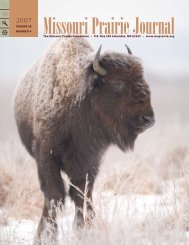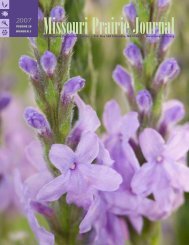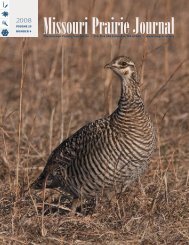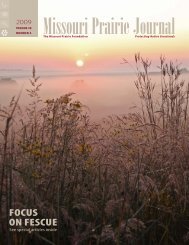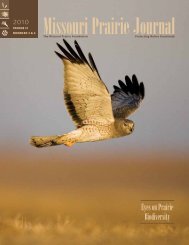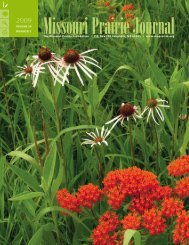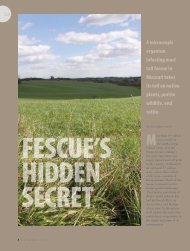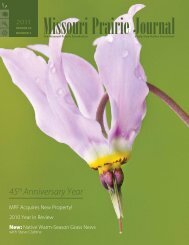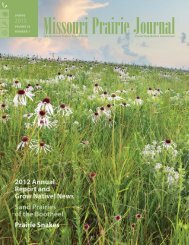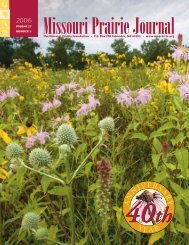Fall & Winter 2012: Volume 33, Numbers 3 & 4 - Missouri Prairie ...
Fall & Winter 2012: Volume 33, Numbers 3 & 4 - Missouri Prairie ...
Fall & Winter 2012: Volume 33, Numbers 3 & 4 - Missouri Prairie ...
Create successful ePaper yourself
Turn your PDF publications into a flip-book with our unique Google optimized e-Paper software.
Cattle producers can benefit<br />
both cattle and quail by<br />
eradicating tall fescue on<br />
part of their land and establishing<br />
native warm-season<br />
grasses and forbs. Native<br />
prairie plants are nutritious<br />
for livestock and create ideal<br />
structure for quail and other<br />
grassland, ground-nesting<br />
bird species.<br />
Conservationists, producers, resource managers, USDA, and<br />
Congress have a clear choice:<br />
1. Repeat history—continue the cyclic pattern of drought<br />
disaster/public aid/drought disaster/public aid/etc., with<br />
public money thrown at short-term band-aids that set producers<br />
up to fail again, while providing sub-par public benefits;<br />
OR<br />
2. Learn from history and apply those lessons—use public<br />
money to provide meaningful, long-term assistance to cattle<br />
producers, in a way that helps insulate them from future<br />
droughts while providing multiple public benefits, including<br />
suitable quail and grassland bird habitats.<br />
In other words, we have a chance right now for solutions<br />
rather than bandages.<br />
The NBCI has already begun promoting our ideas for<br />
a native plant policy for USDA that we call “Natives First.”<br />
Maybe it’s time to take the idea another step, with a new<br />
disaster relief program for “Naturally Drought-proof Pastures”<br />
(idea borrowed from Chuck Kowaleski), that would cost-share<br />
the replacement of a portion of vulnerable introduced-grass<br />
pastures with drought-proof native forage grasses, which would<br />
become an integral part of producers’ risk management plans.<br />
We know Congress and USDA likely will act soon to<br />
provide public aid to cattle producers. What we don’t know<br />
is whether the public’s money actually will provide real, longterm<br />
benefits to the producers, the public and the public’s<br />
wildlife resources … or if it will be just another band-aid.<br />
Reprinted with permission from Don McKenzie’s NBCI-In the News, July 24, <strong>2012</strong><br />
Frank Oberle<br />
Steve CLubine<br />
Ask Steve<br />
Question: I read that nitrates can build up in<br />
grasses, like sudangrass, and hurt or kill cattle. Is this<br />
true for warm-season grasses like big bluestem and<br />
Indiangrass? Also, how should native warm-season<br />
grasses be cared for in a drought? I am considering<br />
haying the fields even though everything is stunted,<br />
but I hate to do that if it would permanently damage<br />
the grasses.<br />
—Jeanne Heuser, Jamestown.<br />
Answer: An article recently made the rounds about cattle<br />
dying in Texas from nitrate poisoning on bermudagrass. It is<br />
uncommon in bermudagrass, but when it is heavily fertilized<br />
with chemical fertilizer or chicken litter, there is potential for<br />
nitrate poisoning. The risk is significantly greater for corn, forage<br />
sorghum, sudangrass, and Johnson grass because of heavy<br />
nitrogen fertilization especially when coupled with drought.<br />
<strong>Prairie</strong>s and native warm-season grasses aren’t normally<br />
fertilized with nitrogen, but if so, with no more than 30–50 lb/<br />
acre, I’ve never heard of anyone ever experiencing nitrate or<br />
prussic acid poisoning on native grasses. Monocultures pose a<br />
greater risk than mixtures of grasses and forbs, which allow the<br />
grazing animal to mix the diet and dilute any negative compounds<br />
and avoid toxic plants.<br />
Whether you fertilize your native grass may depend on<br />
whether you’re haying or grazing it. Haying mines soil nutrients,<br />
particularly phosphorus (P) and potassium (K), gradually<br />
depleting the soil. A 1,000-pound bale removes 8 pounds of<br />
P and 22 lb of K whereas grazing only removes about .04 lb.<br />
of either. You should replace the P and K removed by haying,<br />
but hay rarely pays for the P and K it removes. Nitrogen (N)<br />
is produced naturally by legumes and soil micro-organisms.<br />
Adding N will increase production, but you can’t store it in the<br />
soil, and removing it in a hay bale doesn’t deplete the nutrient<br />
in the soil. Nitrogen will usually pay for itself in increased hay<br />
production or increased animal gain or gain/acre by allowing a<br />
higher stocking rate. Remember, however, adding N acidifies<br />
the soil so watch the soil pH and lime every few years.<br />
J.E Weaver, University of Nebraska professor who studied<br />
prairies extensively, especially during the 1930s drought,<br />
and author of North American <strong>Prairie</strong>, addressed the effect of<br />
drought on prairie plants. He wrote that prairies that were<br />
hayed or grazed during the drought recovered more quickly<br />
when rains returned than those that were idle. Removing<br />
the leaves reduces moisture loss from the roots and soil. The<br />
plants merely go into dormancy or semi-dormancy until conditions<br />
improve later in the growing season or the next season.<br />
Vol. <strong>33</strong> Nos. 3 & 4 <strong>Missouri</strong> <strong>Prairie</strong> Journal 27




